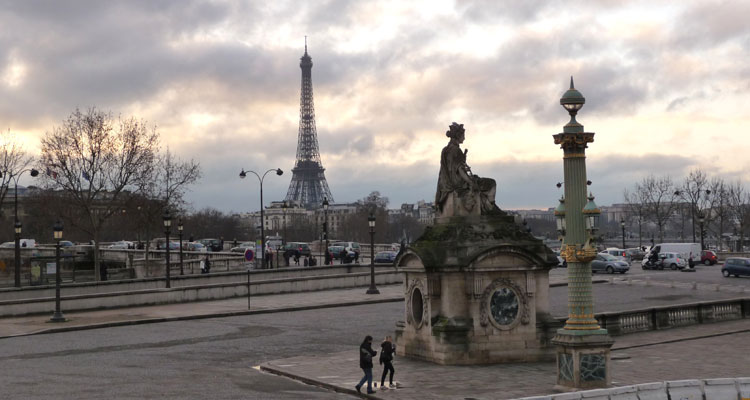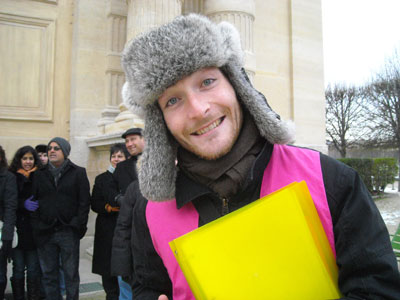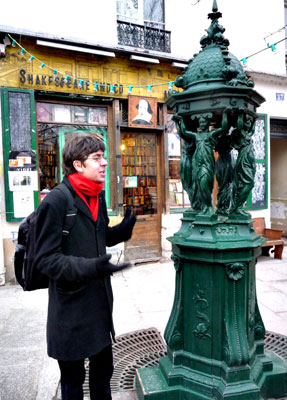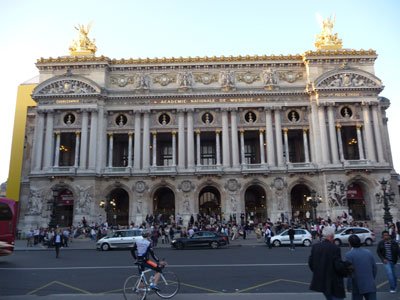A passion for Paris
by George Nevin, Oakland, California
Pop quiz: What do Bob Dylan, Ernest Hemingway, Cyrano de Bergerac, Queen Victoria’s eldest son, the Bloody Mary and the independent Nation of Texas have in common?
Answer: All play a part in the rich lore of Paris, as presented by the outstanding walking tour organization Discover Walks (phone +33 970 449 724).
Discover Walks, founded jointly by a Parisian and a Californian, operates three fun, informative and highly personal walking tours of the City of Light each day, rain or shine. (Two more tours are to be launched in 2011.) They even operate when the weather is literally freezing, as my partner, Susan, and I found out on New Year’s Eve 2010.
What makes Discover Walks unusual is that the tours are conducted in English by native Parisians who love their city. All of the walks are free of charge, but tips are gratefully accepted by the City Guides who conduct them.
The three tours available at the time of our visit were “Paris Landmarks,” on the Right Bank, and “Latin Quarter” and “Notre Dame,” both on the Left Bank. We opted for the 90-minute Latin Quarter tour.
A walk in the cold
David, a university student and passionate Parisian, met our chilled group of 10 under the statue of Charlemagne that faces Notre Dame Cathedral. Soon we were immersed in the mystery, glamour, history, lore and enduring beauty that is Paris.
As we walked from Île de la Cité to the Left Bank, David showed us photos of several historical figures, including Dylan, Hemingway and Cyrano. He promised that we’d encounter each of them on the walk.
By this time, we were on tiny rue de la Bûcherie. There in front of us was the English-language bookstore Shakespeare & Company — and our first celebrity encounter… with Hemingway.
David told us that Hemingway was one of the American authors who felt that France offered a chance for success that was denied them in the United States. Many of these expat authors made Shakespeare & Company their Paris home.
David asked why authors suppressed in the US would be acceptable to the French, then supplied the answer: because the French authorities of the era, whose English was either weak or nonexistent, didn’t really understand the contents of those sizzling volumes.
Literary inspirations
In front of the 14th-century Romanian Orthodox Church on rue Jean de Beauvais, David told us that there used to be a school nearby (since disappeared) where the real Cyrano de Bergerac studied. Cyrano was an actual figure from the mid 1600s whose name was borrowed by late-19th-century author Edmond Rostand for the fictional poet-soldier in his 1897 play “Cyrano de Bergerac.”
On rue Victor Cousin, we paused in front of Hôtel Cluny-Sorbonne, where David explained his mention of Bob Dylan. In the hotel’s Room 62 lived, in 1872, the French poet Arthur Rimbaud, whose work influenced generations of singers and songwriters, including Dylan, Jim Morrison and Patti Smith.
We ended our tour in front of the Sorbonne, where David asked a passing woman to snap a group photo. Each Discover Walks group is photographed, with the shots displayed on the organization’s website so that guests may download them later for their personal use.
One more time
So delighted were we with David’s tour that we returned nine days later for another Discover Walk, this time a stroll along the Right Bank with City Guide Augustin. On this occasion we were the only two people in the “group.”
Augustin told us that he began guiding Discover Walks as a student. After graduating, he cofounded a start-up dedicated to helping businesses become “greener.” He explained, “My company is just getting off the ground, so I generate a little money working as a City Guide.”
Our tour began at the Opéra Garnier, the splendidly ornate opera house dating from 1875. Augustin walked us around the building, explaining that there were originally three entrances: one for the general public, a private one, with a ramp to accommodate a horse-drawn carriage, built so Emperor Napolean III could arrive in peace and safety, and a third one where “rich men could meet the dancers from the opera in a discreet fashion.”
These women, he explained, “were not prostitutes, and it would have been rude to offer them money,” so the men gave the women jewelry. “At about this same time, many jewelers arrived in this district to meet the demand. This was the kind of thing that helped shape Paris.”
Leaving the Garnier, we ducked down a side street, coming to one of Augustin’s favorite parts of the neighborhood, a quiet, traffic-free street leading to a peaceful square with a rich past.
“Here,” said Augustin, indicating place Edouard VII, “was a center for the English who came to Paris in the 19th century.”
Chief among them was England’s Prince Albert Edward, the first son of Queen Victoria and heir to the British crown. “Bertie” liked to frequent brothels in the area. In one, he maintained a private suite complete with a huge copper tub, which he would fill with Champagne and splash around in with his lady friends. After World War II, we were told, the brothel was closed and Salvador Dalí bought the tub.
Lest we think that Albert Edward (later King Edward VII) was nothing but a party animal, Augustin said that the future king was a generous supporter of the architectural heritage of Paris, donating funds for the construction of the nearby Théâtre Edouard VII. Today, Bertie’s statue, astride a prancing horse, stands in front of the theater.
Bars of note
On the swanky rue de la Paix, Augustin pointed out the many deluxe purveyors of jewelry and accessories, such as Cartier, Tiffany, Bulgari and Mont Blanc. “There is at least a million dollars worth of goods in every window,” he told us.
On a side street, he indicated two bars with unusual attributes. The first, called Footsie, was named after Britain’s FTSE 100 index of leading stocks on the London Stock Exchange.
Said Augustin, “There is a big lighted board listing the prices of the drinks, and these fluctuate depending on supply and demand. So if a lot of people come in at the same time and order beer, the price goes up, while the cost of a flute of Champagne may go down because there is no demand.”
The second watering hole, Harry’s New York Bar, was a favorite haunt of Hemingway during the 1920s. It is reputed to be the birthplace of the Bloody Mary, though there is no universal agreement on where this cocktail originated.
A Texan in Paris
by George Nevin, Oakland, California
Leaving behind the glittering displays in the jewelry store windows, we walked through gorgeous place Vendôme, home of the Hôtel Ritz, and soon found ourselves in front of the swanky Hôtel de Vendôme. Augustin pointed out a plaque high above the street that read as follows:
“Texas Embassy – In 1842-43 this building was the headquarters of the embassy of the Republic of Texas in Paris. By the Franco-Texan treaty of 29 September 1839, France was the first nation to recognize the Republic of Texas, an independent nation between 1836 and 1845.”
Said Augustin, “During this time, Texas had left the control of Mexico but wasn’t in the United States yet. The embassy was only here one year.”
We shook our heads. Leave it to a Frenchman to teach a couple of Americans about their own country’s history!
The tour concluded in the Tuileries Garden. Here Augustin, declaring that he likes to end his walks on a high note, gestured over the busy place de la Concorde, thick with traffic and sporting a huge Ferris wheel that often takes up residence here in winter.
To the left, across the Seine, soared the Eiffel Tower. Closer were the imposing Grand Palais and Petit Palais, built in 1897 in preparation for the 1900 Universal Exhibition. Dead ahead, along the Champs-Élysées, was the bulk of the Arc de Triomphe, and towering over Concorde was an ancient Egyptian obelisk, 75 feet high, placed in the square in 1836, a gift from Egypt to France.
Likewise, Discover Walks are a gift to Anglophones from the Discover Walks City Guides — knowledgeable, personable Parisians with a passion for their home city.




